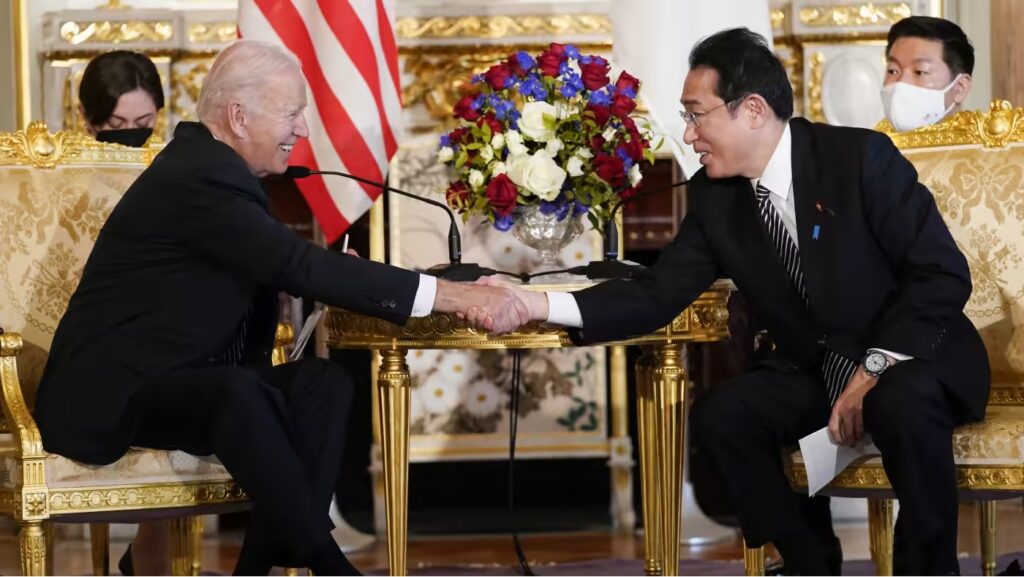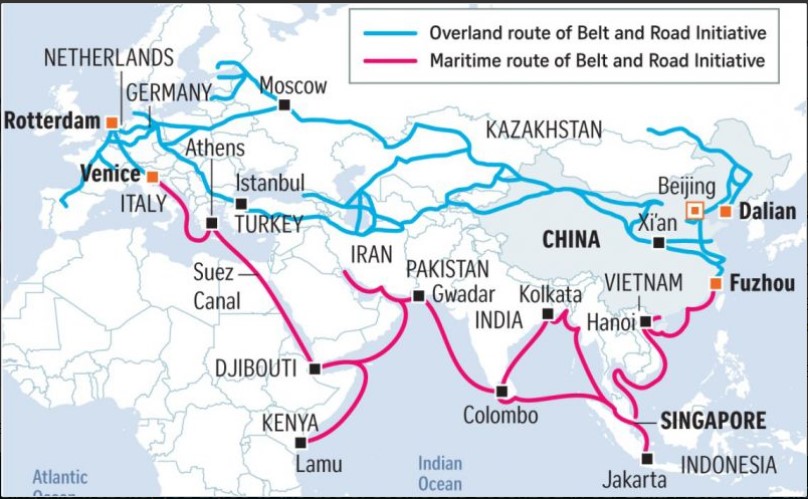|
Getting your Trinity Audio player ready...
|

- China is expanding its influence in the worldwide market and set up a monopolistic market in the coming decades proving to be the greatest threat to the US.
- The US is trying to adopt a strategy known as Task Force which seeks to improve the US competitiveness and reduce the economic risk possessed by BRI.
- The US trade agreement with twelve Indo-Pacific countries is a major threat to China’s dominance over the region.
- The US partnership with Asian countries reflects the strategy of alliances during the cold war period.
The post-Soviet power shifts witnessed the formation of a US rule-based world order. Since 1991, the US has emerged as a global power stretching its economic, military and cultural influence worldwide. However, the US is facing a significant threat from the emergence of a multi-polar world order, with the rise of China, Japan, India, Russia, Germany, South Africa and other power centres worldwide. Under President Biden’s leadership, the US government realized the significance and potentiality of the rise of Asia (China-Japan-India) and focused on strengthening bilateral and multilateral relations with Asian states to secure its military, economic and strategic interests.
On January 20, 2021, Joe Biden, a Democrat, signed the office as the 46th President of the United States of America, defeating Trump in the 2020 presidential election. He took office amidst the Covid-19 pandemic when the economic crisis was at its peak. However, under President Biden’s leadership, it has been observed that the Economy has touched new heights creating far more employment opportunities and promoting increased competition in the American Economy.
Rise of China (BRI): An Incoming Threat to the US Supremacy
As Napoleon once said, “When China woke from its slumbers, it would astonish the world” the historic rise of China marks a clear indication of the threat to the US hegemony. Many scholars have already predicted that there will be a significant shift from American dominance to Chinese dominance in terms of economic power within twenty years.
The Belt and Road Initiative, also referred to as the New Silk Road, is considered one of the Chinese government’s most ambitious projects. The term “Belt and Road Initiative” was formulated in 2013 by the President of China, Xi Jinping, who was inspired by the concept of the Silk Route established by the Chinese Han Dynasty. Previously known as the “One Belt One Road“, the project primarily aims to increase global connectivity to enhance trade relations. It further focuses on facilitating trade and investments, vitalizing local currencies, and strengthening people-to-people exchange.
The Silk Road Economic Belt desires to focus on infrastructural development and intensify connectivity and economic development by designing six international “corridors” in the Eurasian region, namely:
- China-Mongolia-Russia Economic Corridor (CMREC)
- New Eurasian Land Bridge Economic Corridor (NELBEC)
- China-Central Asia-West Asia Economic Corridor (CCWAEC)
- China-Indochina-Peninsula Economic Corridor (CICPEC)
- Bangladesh-China-India-Myanmar Economic Corridor (BCIMEC)
- China-Pakistan Economic Corridor (CPEC)
Adding to this, the 21st century Maritime Silk Road connects- China to Southeast Asia, Indonesia, India, the Arabian Peninsula, Somalia, Egypt and Europe, surrounding the South China Sea, Strait of Malacca, Indian Ocean, Gulf of Bengal, Arabian Sea, Persian Gulf and the Red Sea.
This project is an umbrella mechanism initiated by the Chinese government to replace the US hegemony in the coming decades by connecting with the European and Asian regions. This comes under China’s “Major Country Diplomacy,” for which the country is highly investing in developing infrastructures like railways, roads, ports and airports and advancing power plants and telecommunication networks across the region.

Implications of BRI on the US
China’s most aspiring project, the Belt and Road Initiative, has proved to be one of the significant threats to the US and its economic interests. Since the launch of this project, the Chinese government has started to invest in developing infrastructures like railways, roads, ports, telecommunication, power plants and highways across the world. While doing so, China is also providing huge loans to many developing nations, mainly the South Asian countries, which may lead to debt traps, economic dependencies and potential environmental threats to these countries.1
China’s goal is not only to become a regional power in the Asia- Pacific region but also to establish itself as a global power. According to China’s action plan, it can be said that China is trying to expand its influence in the worldwide market and set up a monopolistic market in the coming decades. All of these have proven to be the greatest threat to the United States which is currently the leading superpower. To counter the Belt and Road Initiative (BRI) project, the United States of America is trying to adopt a strategy known as Task Force which seeks to improve the US competitiveness and reduce the economic risk possessed by BRI (ibid).
The Task Force recommends the following to improve the competition:
- Allocating an additional $100 for research and development funding, with further investments in universities and research institutions to invest in cutting-edge research and enhance support for private-sector investment in next-generation technologies;
- Rising funds in basic science, technology, engineering, and mathematics (STEM) education at all levels;
- Revising immigrants and visa policies to make it easier to attract and retain the world’s intelligent students, researchers, scientists, and engineers;
- Boosting coordination and allocating more incredible support for participation in the international standards-setting bodies;
- Promoting alternatives to the US digital transformation to third world countries;
- Refining the Development Finance Corporation and reforming the US export-import bank by providing them with greater flexibility to compete with the BRI and partner it with other development finance institutions from around the world (ibid).
US and Twelve States Trade Agreement
To counter China’s growing monopoly in Asia, Joe Biden, the President of the United States of America, announced a joint trade agreement with twelve Asian countries – Australia, Brunei, India, Indonesia, Japan, South Korea, Malaysia, New Zealand, the Philippines, Singapore, Thailand, and Vietnam. They generate 40% of the world GDP along with the United States. This initiative was planned to work on issues including supply chains, digital trade, clean energy and anti-corruption efforts and consequently boost economic engagement in the region.2
On the eve of the QUAD summit in Tokyo, Biden declared the Indo-Pacific Economic Framework for Prosperity (IPEF) on May 23, 2022, after meeting Fumio Kishida, the Prime Minister of Japan, on his first visit to Asia as the US President.3
Gina Raimondo, the US commerce secretary, stated, “IPEF was an important turning point in restoring US economic leadership in the region”. Moreover, the US national security adviser, Jake Sullivan, said, “The fact that we have such a range and a significant number of partner countries on the ground floor for the launch… indicates that there’s deep interest across the region.” She added that the Indo-Pacific was projected to be the biggest driver of global growth for 30 years.
The Indo-Pacific Economic Framework (IPEF) focuses on four key pillars to determine high-standard commitments that will deepen our economic engagement in the region:
- Connected Economy,
- Resilient Economy,
- Clean Economy,
- Fair Economy.
As Katherine Tai, the US trade representative, stated, “Our aim for IPEF is to address the challenges in the 21st-century global economy.” However, many South-eastern countries did not validate this framework because the IPEF disapproved of the US market. Japan recommended the US alternate the launch statement to increase the number of participants to join the IPEF. The head of the Japan Institute of International Affairs stated that Japan is supporting the IPEF because, “Considering the position the US is in at the moment, the IPEC gives the US its best shot to take the initiative in the region and maintain its economic presence”.4
Impact on China and India
The US trade agreement with twelve Indo-Pacific countries is a major threat to China’s dominance over the region. The Chinese government went to the extent to termed this agreement as an “economic NATO”.5
The Foreign Minister of China, Wang Yi, through a video link addressing the Economic and Social Commission for Asia and the Pacific (ESCAP), stated, “China will continue to focus on the Asia-Pacific for its benefit and make greater contributions to its lasting peace and sustainable development with concrete actions”. He further added that Beijing would focus on the advancement of China’s accession to the Comprehensive and Progressive Agreement for Trans-Pacific Partnership and the Digital Economy Partnership Agreement to counter the new trade and economic initiative of the Quad alliance, without mentioning the IPEF. In dealing with the rising interference of the US in the Indo-Pacific region, Wang Yiwei, director of the Institute of International Affairs at the Renmin University of China, suggested that China upgrade its Regional Comprehensive Economic Partnership (RCEP) cooperation such as accelerating digital partnership negotiations with ASEAN members.6
Nevertheless, Taiwan was excluded from this initiative to avoid China’s hostility. However, this became a matter of considerable controversy as many countries objected to how the US could completely exclude Taiwan from a meaningful agreement on the supply chain as the country is an essential manufacturer of semiconductors.
Several significant powers, including India and the United States, discuss the need to ensure a free, open, and flourishing Indo-Pacific in the backdrop of China’s rising military dominance in the region. India’s friendship with the United States shares a lot of history; thus, the US is India’s preferred partner on security issues. Both the countries associate to safeguard maritime security and counter Chinese influence in the Indo-Pacific region.
Conclusion
The rising growth of China as a global economic power is a major threat to the US hegemony. China’s expansion in the South and Southeast Asian region through various projects like the Belt and Road Initiative (BRI) is serious competition to US dollars. To counter the rise of China in Asia, the United States of America, under the leadership of Joe Biden, came up with one of the most ambitious strategies known as the US Trade Agreement with twelve Asian States. This partnership reflects the strategy of alliances during the cold war period. Apart from this, the US is involved in many such associations like Quadrilateral Security Dialogue (QUAD), Central Treaty Organization (CENTO) and Southeast Asia Treaty Organization (SEATO) to counter the growth of Chinese dominance in Asia.
(Aatrayee Deka, Research Student, Department of Political Science, St. Joseph’s University (SJU), Bengaluru, Karnataka. Dr. Karamala Areesh Kumar, teaches International Relations and World Politics at PG and Research Centre, St. Joseph’s University (SJU), Bengaluru, Karnataka.)
References
1 Hillman Jennifer and Sacks David (2021); Council on Foreign Relations; China’s Belt and Road: Implications for the United States; https://backend-live-tfr.cfr.org/.
2 New York Post (2022); the US and 12 countries join the new Indo-Pacific trade pact; https://nypost.com/2022/05/23/us-and-12-countries-join-new-indo-pacific-trade-pact/.
3 The White House (2022); On-the-Record Press Call on Launching the Indo-Pacific Economic Framework; https://www.whitehouse.gov/briefing-room/press-briefings/2022/05/23/on-the-record-press-call-on-the-launch-of-the-indo-pacific-economic-framework/.
4 Sevastopulo Demetri and Inagaki Kana (2022); Financial Times; Joe Biden launches trade agreement with 12 Asian nations; https://www.ft.com/content/e2634c2a-3709-4a31-a419-1e30af1fc607.
5 Firstpost (2022); China sees Joe Biden’s new trade deal with 12 Indo-Pacific nations as a threat to its regional dominance; https://www.firstpost.com/world/china-sees-joe-bidens-new-trade-deal-with-12-indo-pacific-nations-as-threat-to-its-dominance-in-region-10712931.html.
6 Ibid.
